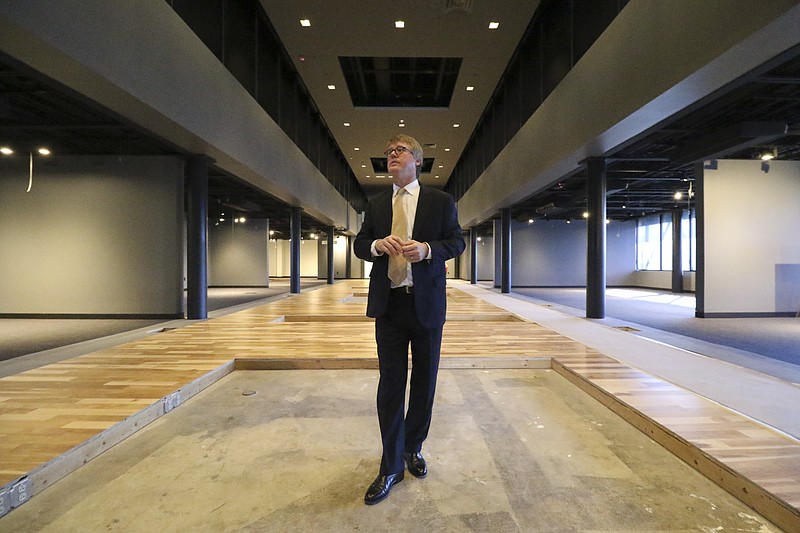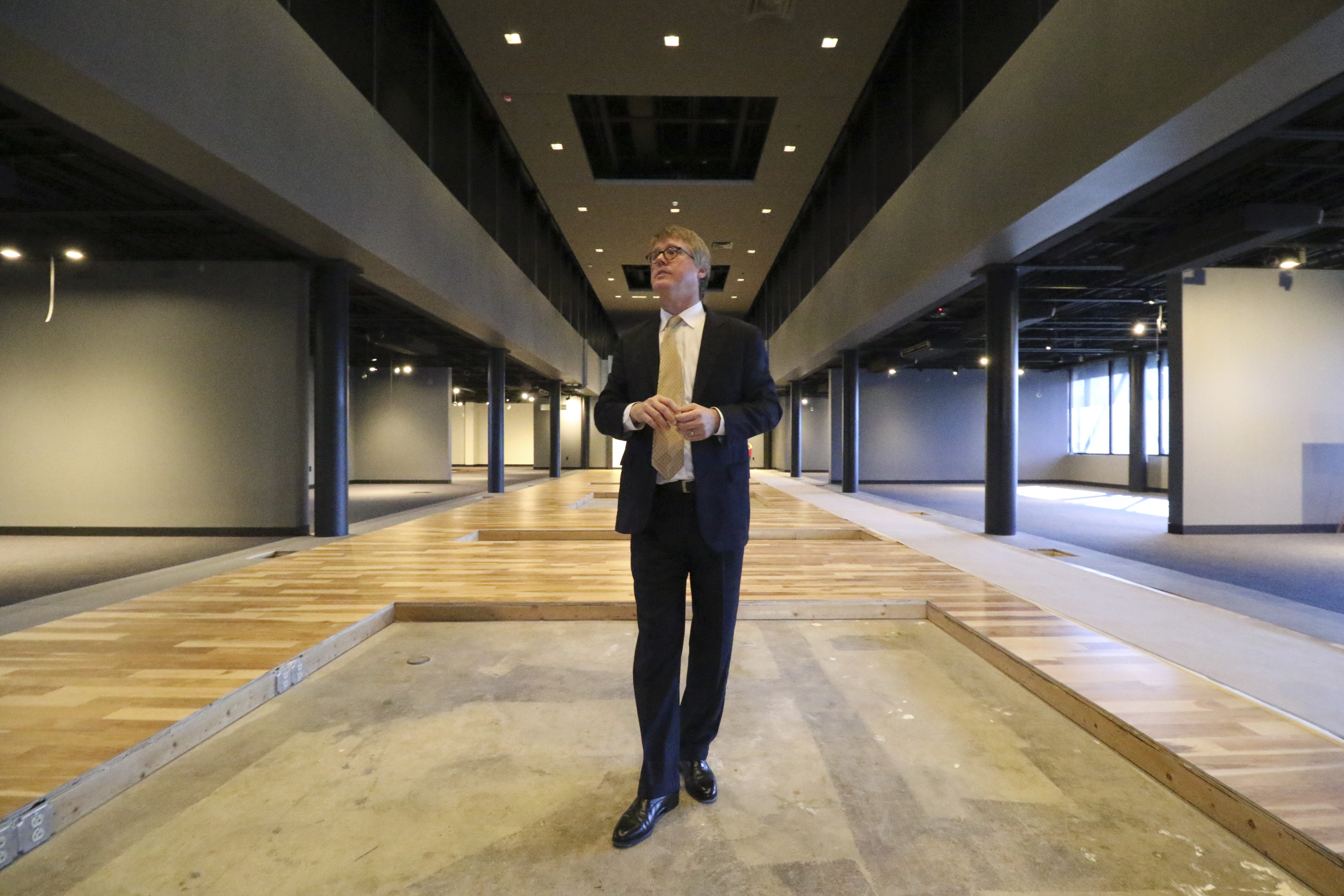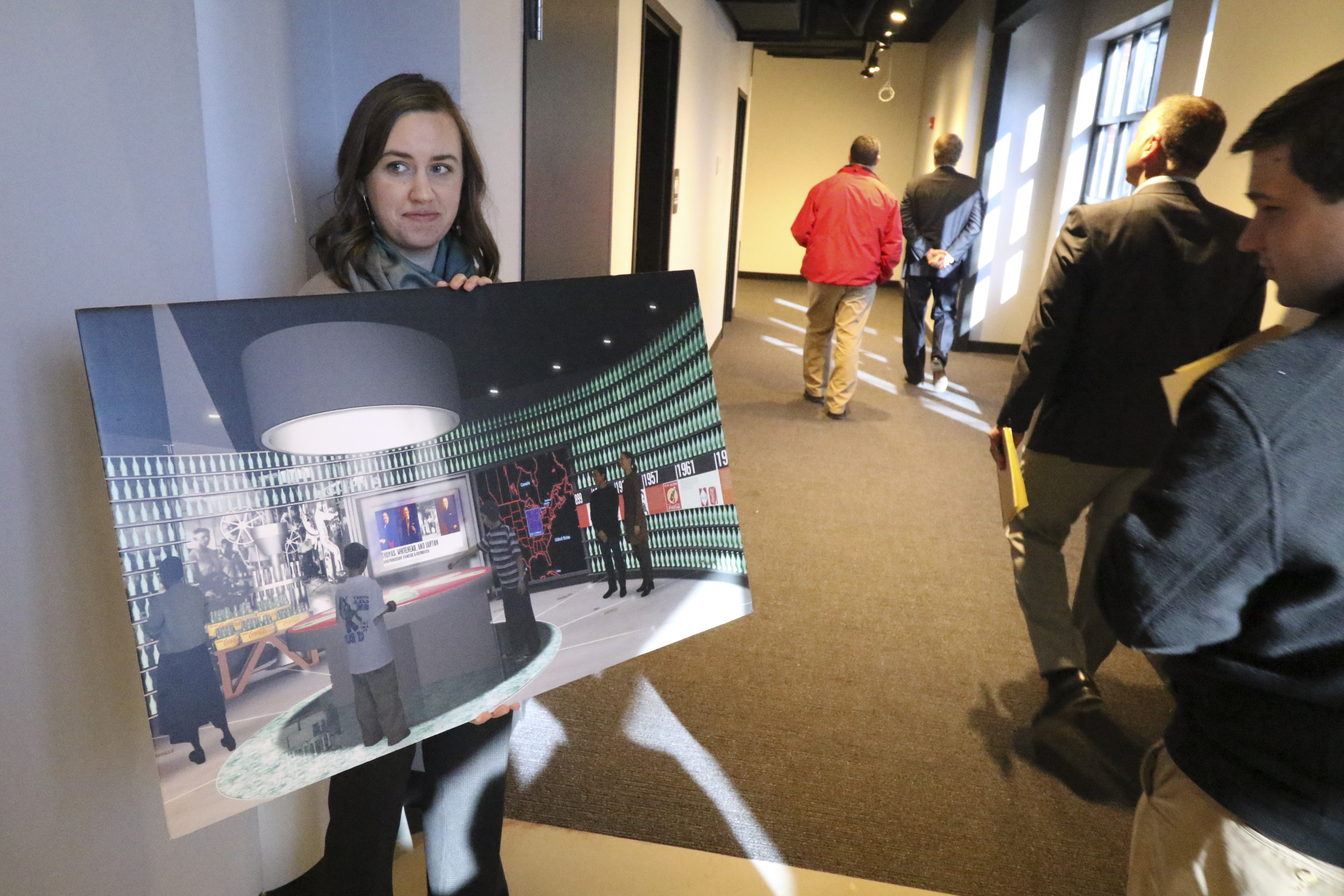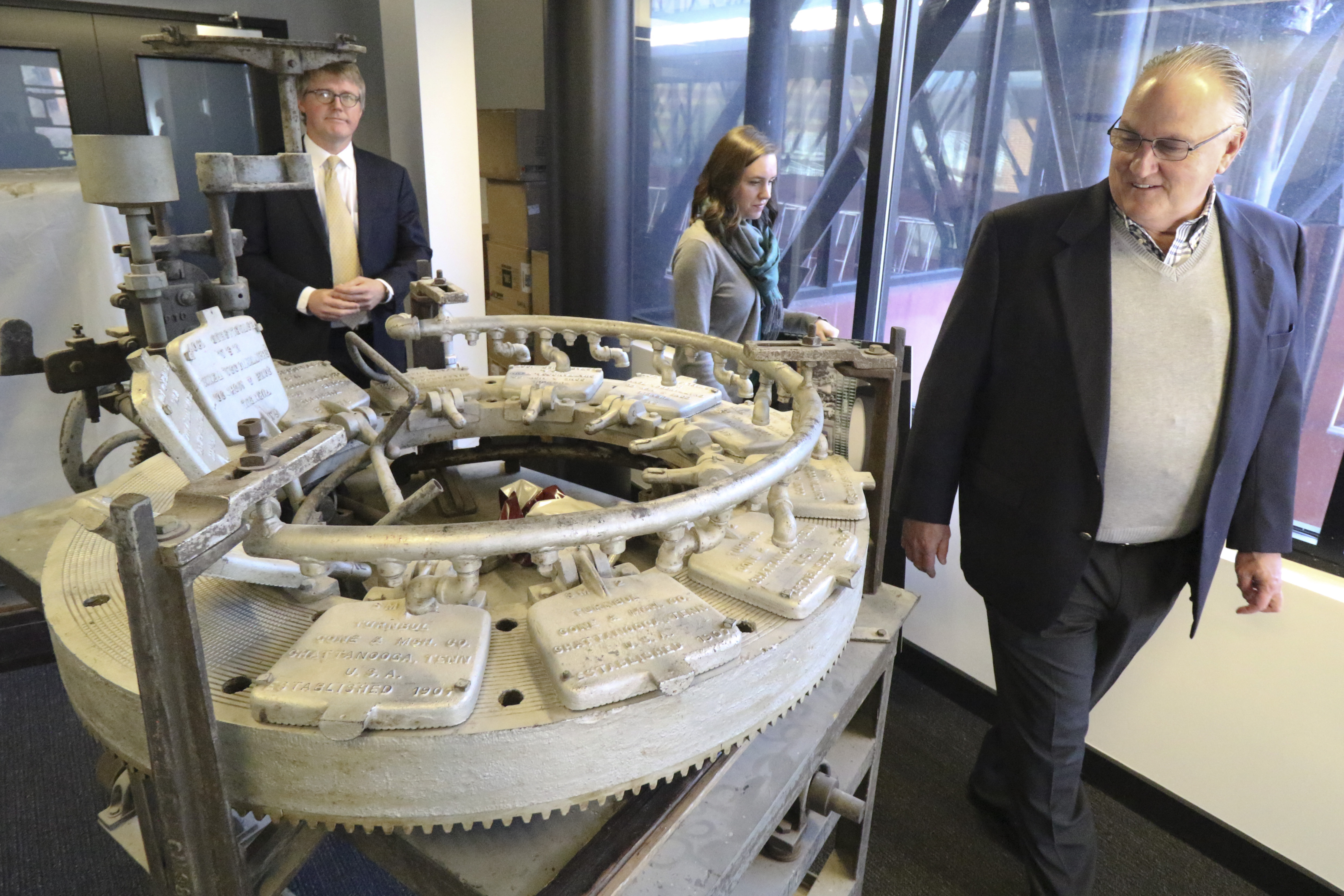There is no Plan B for what to do if the money doesn't come this year."
The Chattanooga History Center was touted as revolutionary. Not your grandfather's museum. No glass cases with dusty artifacts. Instead, it would be a colorful, airy museum alive with stories from the past.
The original opening date was slated for mid-2012. Then it was early 2013. Then it was 2014.
Now, Museum Director Daryl Black refuses to even estimate when it might open. But he's still adamant it will open.
For months the museum has said it's only a few hundred thousand shy of its $10.5 million capital campaign goal, which would allow Black to open the doors and let the public view his cutting-edge exhibits.
But last week, Black and museum board members told the Times Free Press they still need more than $3 million: $1.86 million to pay a New York museum designer to build the exhibits and $1.3 million to pay off the mortgage.
"The news about the additional amount -- the $3.2 million -- is startling. And it's something I want to know a little more about now," said Bruz Clark, president of the Lyndhurst Foundation, which has given $750,000 to the project.
The nonprofit museum's 20-member board comprises many of the city's business elite, but some board members concede wealthy donors are growing impatient about the museum's progress. Foundations and individuals have already made generous contributions -- which makes it difficult to approach them yet again, said board treasurer Carl Henderson.
"It has to be annoying for their part, because they thought when you were there the first time this is what you need," he said. "And now we need a little more. That has to be disconcerting on their part."
So far, the museum's capital campaign has tallied up about $10.3 million. In the meantime, the organization is spending more than half a million each year operating a museum that isn't even open, though it does offer community and educational programs.
Now the board has decided the only way to get the $3.2 million it needs to open the museum is to borrow it. Henderson recently met with several banks but discussions are very preliminary.
"There is no Plan B for what to do if the money doesn't come this year," Black said. "The money is coming. We're moving toward that money even as we're talking here. There is a plan and a strategy."
Construction on renovating the space is complete. The museum's benches, metal frames and glass partitions have been built and paid for and are awaiting installation inside the building. But the exhibits -- the photographic images, graphics, text -- cannot be built or installed until the museum obtains more money.
The history center, a three-story glass and concrete tower that once housed the Convention and Visitors Bureau, sits across the plaza from the Tennessee Aquarium. The 11,000-square-foot museum is on the second floor.
It is a dramatic space with a soaring atrium pierced by shafts of light. One day it will be flanked by small galleries hosting exhibits on different historical themes including how Chattanooga's black community and leaders shaped the city, efforts to clean the air and water after Chattanooga became America's dirtiest city and the railroad's role in industry and the Civil War. Mock-ups of the exhibits mark spots in the empty space where those galleries will be.
Black remains confident that the museum, once opened, can eventually support itself and repay its debt primarily on ticket sales, which experts say would be almost unheard of among American museums.
"There's not a museum in the world I'm aware of that can support itself off the gate alone," said Tennessee Association of Museums President Adam Alfrey. "Even the most popular museums in America rely on sponsorships and grants, revenue streams other than gate."
Alfrey is operations manager and exhibition curator of the East Tennessee History Center in Knoxville, which he said is financially successful. He said cities the size of Chattanooga normally are most successful attracting regional visitors rather than drawing from a national pool.
But Black thinks the museum will draw tourists from all over. He thinks its proximity to the Tennessee Aquarium will provide an extra boost. Black says 1 in 10 of the aquarium's 750,000 annual visitors will buy a museum ticket, though a hired consultant predicted 69,000 annual visitors.
The museum will display 300 items from the 30,000 in its collection. It includes sections on the Trail of Tears, the Civil War, Coca-Cola bottling and the Tennessee Valley Authority. Black called one of the videos he produced about crises in Chattanooga's past the most inspiring and exciting history video he's ever seen.
But one of his favorite planned exhibits is a "memory lantern," a screen that juts from the ceiling where a video about Chattanooga in the civil rights era plays. Black said he searched for TV footage of the protests, meetings and sit-ins during the 1950s and '60s, but local TV stations had little in their archives. He was able to find only 90 seconds of film from that era, so the video uses images of marching feet and downtown Chattanooga as the voices of local civil rights legends share their memories. These are issues people from all over can appreciate, he says.
"This is a great story because it's national in scope," Black said.
* * *
Current board members called the city's former museum a dusty funeral parlor, a morgue. The Chattanooga Regional History Museum was founded in 1978 and its first home was Missionary Ridge Elementary School. It later moved downtown to Fourth and Chestnut streets.
There's not a museum in the world I'm aware of that can support itself off the gate alone."
In 2000, the city donated an adjacent building to the downtown museum and in 2006 the name changed to the Chattanooga History Center. Daryl Black was hired to be a curator. In 2007, developer Henry Glascock proposed a massive new eight- or nine-story development at the corner of First and Market streets that would be anchored by the new museum. But that project faltered with the economy. The next year, the museum sold off its properties and moved into a temporary location on Lindsay Street.
In 2009, the board promoted Black. He was an academic, a former history professor and adjunct instructor. He taught at the University of California, Irvine, and the University of Tennessee at Chattanooga. Aside from his curating experience, he had not been employed by a museum before.
Black's vision inspired board members and donors. He wanted the museum to be not just a place that displays artifacts, but one that sparks discussion and reflection by tackling tough issues like slavery, race and the impact people have on the local environment.
And only the best would do. Early on, he hired the prestigious New York-based Ralph Appelbaum Associates, which has worked on the NASCAR Hall of Fame in Charlotte, N.C.; The Newseum in Washington, D.C.; and the Country Music Hall of Fame in Nashville.
And he went after a prime waterfront location. That building, purchased for about $2.3 million, is turning out to be the museum's greatest asset, but also one of its greatest challenges.
The nonprofit River City Co. holds a $1.8 million mortgage on the space (The downstairs space, soon to be Puckett's restaurant, is separately owned). River City has allowed the museum to hold off repayment for about two years during the fundraising drive and has offered a sweet deal: if the balance is paid by July of this year, River City will forgive the interest and accept a $1.3 million payout, plus another $100,000 to be paid after five years. Otherwise, the museum will have to start making mortgage payments this year.
Board members want to take advantage of the offer. So they're looking for $3.2 million in bank financing to pay off the mortgage balance and build their exhibits.
With a recent appraisal of more than $6 million for the space, Henderson says the museum is more than good for the loan. But so far, federal lending regulations have complicated a deal. So board members are looking for a major donor to back a bank loan.
"With that kind of equity in that piece of property, there's no question in my mind we'll get it done," Henderson said. "It's just a question of when and who is the party that actually steps up."
* * *
Henderson, of the Henderson, Hutcherson and McCullough CPA firm, has volunteered as the museum's treasurer for two years now, which could be a nerve-shredding role. When he came on board, another nonprofit's accounting staff was trying to manage the museum's finances as a favor, but it was already swamped with other assignments. The result was financial paperwork chaos.
"Our monthly financial statements were 60 to 90 days behind," Henderson said, noting this made it almost impossible to plan a budget.
When he went to banks to find out how much could be borrowed against donors' pledges, banks refused to tell him, citing confidentiality practices. He was able to figure it out by painstakingly reviewing records. He brought in a CPA who agreed to manage the museum's finances in exchange for a bookkeeper's pay.
It seems a formidable task for a volunteer to shoulder. But Henderson believes in the museum's mission and describes himself as a devoted history buff who grew up on tales of Andrew Jackson and the Civil War. He was especially moved by the exhibit Black devoted to the Trail of Tears. Appelbaum staffers went to Oklahoma to interview descendants of Cherokees who walked that trail.
The museum spent about $4 million on construction and when it's done will have spent about $4.5 million on Appelbaum contracts. The museum's interactive budget was spent entirely on the videos. The introductory piece has a voiceover by homegrown mega-movie star Samuel L. Jackson, who starred in such films as "Pulp Fiction," "Star Wars" and "Snakes on a Plane." He does not appear on screen. He reads a script mentioning highlights of Chattanooga history over images of rivers, mountains and the city.
Appelbaum is a prestigious, internationally respected firm but not inexpensive. When asked if in retrospect, a less costly firm could have produced the videos and designs of the same quality, Black and board members stood by the hiring of Appelbaum. And their vision received some validation with a $400,000 grant from the National Endowment for the Humanities this summer.
Like other board members, Henderson admires Black's creativity and history scholarship. And he believes Black's vision for the museum will come to fruition and Chattanoogans and visitors alike will love it.
Henderson feels an urgency to get through the financial hurdles and let the public in on Black's dream.
The museum lost more than half a million in fiscal 2014. It spends $163,321 on salaries annually. Black earns $86,000 annually. His curator earns $34,000. No one has health insurance. There is also a staffer who oversees educational outreach programs like weekend classes and a deputy director. Although the museum is not open, tax filings for 2013 show $153,326 spent on marketing. The bulk of that goes to The Johnson Group which manages public relations and all social media for the museum, including its website which shows an opening date of 2014.
Henderson said the project hasn't gone over budget; rather, he says the initial $10.5 million goal was inadequate.
And no one could have predicted how dramatically the funding landscape would change. Since Black came on board:
* After giving $578,000 in operations and capital, the city government pulled its funding, though officials said they might reconsider new requests once the museum is operational.
* In recent years, the county has refused museum funding requests.
* Jack Lupton, a giant in the world of civic giving, died in 2010. And so far the board has found it hard to identify the new money players in town.
The board knows there were doubters. Still are.
But they say people doubted the aquarium, too.
Contact staff writer Kevin Hardy at khardy@timesfreepress.com or 423-757-6249.
Contact staff writer Lynda Edwards at ledwards@timesfreepress.com or 423-757-6391.



